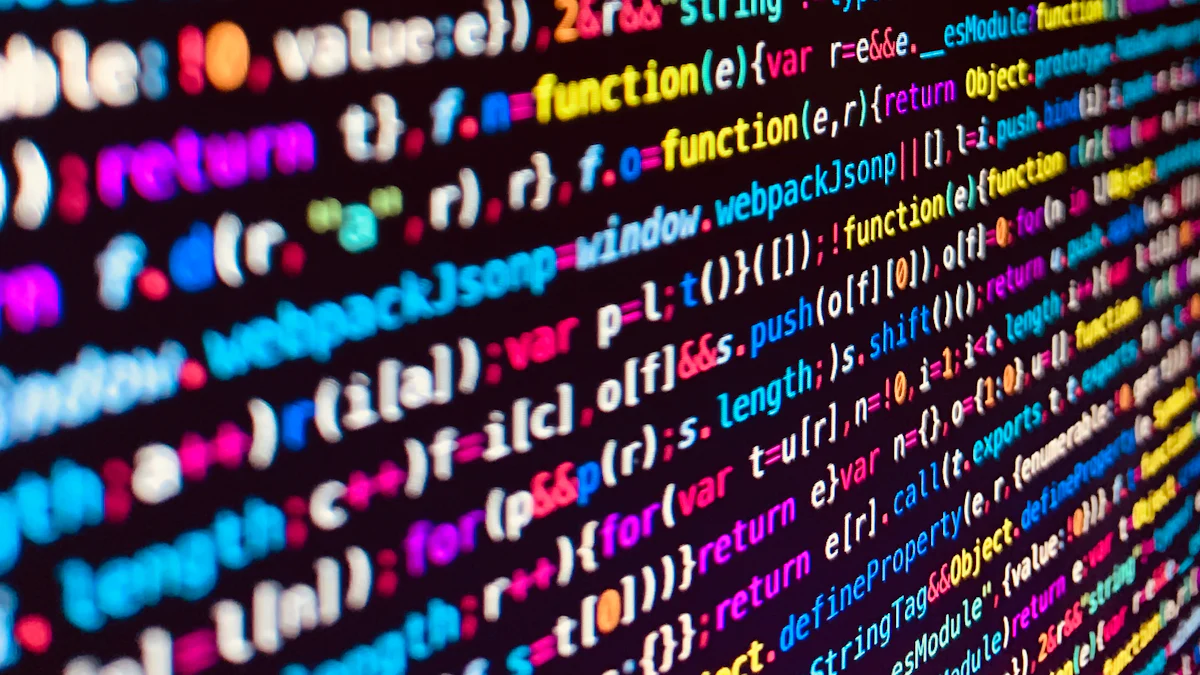Why Python is the Go-To for Artificial Intelligence

ARTIFICIAL INTELLIGENCE WITH PYTHON stands as a cornerstone in the realm of AI. The language's simplicity and versatility make it an ideal choice for AI development. Various industries, including fintech, healthcare, and transportation, increasingly rely on AI to enhance efficiency and innovation. ARTIFICIAL INTELLIGENCE WITH PYTHON continues to grow in popularity, driven by its extensive libraries and robust community support. The language consistently ranks among the top choices for AI and Machine Learning (ML) tasks, solidifying its status as the go-to programming language for AI.
ARTIFICIAL INTELLIGENCE WITH PYTHON: Features and Benefits

Simplicity and Readability
Easy Syntax
Python's syntax mirrors natural language, making it accessible for beginners and experts alike. The straightforward structure reduces the learning curve and accelerates the development process. This ease of use allows developers to focus on solving complex AI problems rather than grappling with intricate code.
Rapid Prototyping
Python enables rapid prototyping, which is crucial in the fast-paced field of AI. Developers can quickly test ideas and iterate on models without extensive overhead. This agility fosters innovation and speeds up the deployment of AI solutions.
Extensive Libraries and Frameworks
TensorFlow and Keras
TensorFlow and Keras stand out as powerful libraries for AI development. TensorFlow offers robust tools for building and training machine learning models. Keras, a high-level API, simplifies the creation of neural networks. Together, these libraries provide a comprehensive toolkit for AI projects.
PyTorch
PyTorch has gained popularity for its dynamic computational graph and ease of use. Researchers and developers favor PyTorch for its flexibility and efficiency in model building. The library's intuitive interface supports seamless experimentation and debugging.
Scikit-learn
Scikit-learn excels in providing simple and efficient tools for data mining and analysis. The library includes various algorithms for classification, regression, clustering, and more. Scikit-learn's user-friendly interface and comprehensive documentation make it a go-to resource for machine learning tasks.
Community Support and Resources
Online Forums and Tutorials
The Python community offers extensive support through online forums and tutorials. Platforms like Stack Overflow and GitHub host a wealth of knowledge and code examples. These resources enable developers to troubleshoot issues and learn best practices from peers.
Open-Source Contributions
Python's open-source nature encourages contributions from developers worldwide. This collaborative environment leads to continuous improvements and innovations in AI libraries and frameworks. The collective effort ensures that Python remains at the forefront of AI development.
Integration and Flexibility
Compatibility with Other Languages
Python's compatibility with other programming languages enhances its utility in AI projects. Developers often integrate Python with languages like C++ for performance-critical tasks. This integration allows the use of Python's simplicity while leveraging the speed of C++. Additionally, Python can interface with Java, enabling seamless data exchange and functionality sharing between systems. This cross-language compatibility ensures that ARTIFICIAL INTELLIGENCE WITH PYTHON can operate within diverse tech stacks.
Versatility in Different Domains
Python's versatility extends across various domains, making it a preferred choice for AI applications. In fintech, Python aids in fraud detection and algorithmic trading. Healthcare professionals use Python to develop predictive models for patient outcomes and disease diagnosis. The transportation industry benefits from Python's capabilities in route optimization and autonomous driving technologies. A notable example includes Skyscanner, which utilized a Python unsupervised ML algorithm to predict new airplane routes' behavior. The results displayed on a dashboard allowed users to see groups of destinations and their characteristics. This versatility demonstrates Python's adaptability in solving domain-specific problems.
Practical Applications of ARTIFICIAL INTELLIGENCE WITH PYTHON

Machine Learning
Data Analysis and Visualization
Python excels in data analysis and visualization, which are critical components of machine learning. Libraries such as Pandas and Matplotlib provide robust tools for data manipulation and graphical representation. Pandas allows efficient data handling and preprocessing, while Matplotlib offers extensive plotting capabilities. These libraries enable developers to gain insights from data and present findings in an understandable format.
Model Training and Evaluation
Model training and evaluation form the backbone of machine learning. Python's [Scikit-learn](https://www.newhorizons.com/resources/blog/why-is-python-used-for-machine-learning) library simplifies these processes with its comprehensive suite of algorithms and tools. Developers can easily train models using various techniques such as regression, classification, and clustering. Scikit-learn also provides metrics and methods for evaluating model performance, ensuring accurate and reliable results.
Natural Language Processing
Text Analysis
Natural Language Processing (NLP) benefits significantly from Python's capabilities. The NLTK (Natural Language Toolkit) library offers a wide range of tools for text processing and analysis. Tasks such as tokenization, stemming, and sentiment analysis become straightforward with NLTK. This library empowers developers to extract meaningful information from textual data, enhancing applications like content categorization and opinion mining.
Chatbots and Virtual Assistants
Python plays a pivotal role in developing chatbots and virtual assistants. Libraries like ChatterBot and Rasa facilitate the creation of conversational agents. ChatterBot enables the development of chatbots that can learn from interactions, while Rasa provides a framework for building sophisticated virtual assistants. These tools leverage machine learning to understand and respond to user queries, improving customer service and user engagement.
Computer Vision
Image Recognition
Computer vision tasks such as image recognition benefit from Python's extensive libraries. OpenCV (Open Source Computer Vision Library) stands out for its powerful image processing capabilities. Developers can use OpenCV to perform tasks like object detection, face recognition, and image segmentation. This library supports various algorithms and techniques, making it a versatile tool for computer vision projects.
Object Detection
Object detection involves identifying and locating objects within images or videos. Python's TensorFlow and PyTorch libraries offer pre-trained models and frameworks for object detection. These libraries enable developers to implement advanced techniques such as YOLO (You Only Look Once) and SSD (Single Shot MultiBox Detector). The integration of these tools facilitates the development of applications like surveillance systems and autonomous vehicles.
Comparisons with Other Programming Languages
Python vs. R
Ease of Use
Python offers a straightforward syntax that resembles natural language. This makes Python accessible to both beginners and seasoned developers. The simplicity of Python's syntax reduces the learning curve, allowing users to focus on developing AI models rather than deciphering complex code structures.
R, on the other hand, has a steeper learning curve. The syntax of R can be more challenging for newcomers. R often requires a deeper understanding of statistical concepts, which may not be intuitive for all users. This complexity can slow down the development process.
Library Support
Python boasts an extensive range of libraries tailored for AI and machine learning. Libraries such as TensorFlow, Keras, and Scikit-learn provide comprehensive tools for building and training models. These libraries offer robust support for various AI tasks, making Python a versatile choice.
R also has a strong library ecosystem, particularly for statistical analysis. Libraries like caret and randomForest are popular for machine learning in R. However, the breadth and depth of Python's libraries give it an edge in AI development. The integration of Python with cloud data warehouses further enhances its capabilities, enabling hyper-fast analysis and improving data quality.
Python vs. Java
Performance
Java is known for its performance efficiency. The compiled nature of Java allows for faster execution times compared to interpreted languages. Java's performance makes it suitable for large-scale applications where speed is critical.
Python, while not as fast as Java, compensates with its ease of use and rapid development capabilities. The interpreted nature of Python allows for quick prototyping and iterative testing. This agility is crucial in AI development, where models often require frequent adjustments and refinements.
Community and Resources
Python benefits from a vast and active community. Online forums, tutorials, and open-source contributions provide extensive support for developers. Platforms like Stack Overflow and GitHub host a wealth of knowledge, enabling users to troubleshoot issues and learn best practices.
Java also has a strong community, but Python's focus on AI and machine learning gives it an advantage. The collaborative environment in the Python community fosters continuous improvements in AI libraries and frameworks. This collective effort ensures that Python remains at the forefront of AI development.
Python vs. C++
Speed and Efficiency
C++ excels in speed and efficiency. The compiled nature of C++ results in high-performance execution, making it ideal for performance-critical tasks. C++ is often used in applications where low-level hardware interaction and real-time processing are essential.
Python, while not as fast as C++, offers a balance between performance and ease of use. Python's compatibility with C++ allows developers to integrate performance-critical components written in C++ with the simplicity of Python. This integration leverages the strengths of both languages, providing a versatile solution for AI projects.
Learning Curve
Python's learning curve is relatively gentle. The clear and readable syntax of Python makes it accessible to a wide range of users. This accessibility accelerates the learning process, enabling developers to quickly become proficient in AI development.
C++ presents a steeper learning curve. The complexity of C++ syntax and the need for manual memory management can be challenging for beginners. This complexity requires a deeper understanding of programming concepts, which can slow down the learning process. However, the performance benefits of C++ make it a valuable tool for specific use cases.
In conclusion, each programming language has its strengths and weaknesses. Python stands out for its simplicity, extensive libraries, and strong community support. These features make Python the preferred choice for AI development, offering a balance between ease of use and powerful capabilities.
Python's simplicity, extensive libraries, and strong community support make it the preferred choice for AI development. The language offers a versatile ecosystem that caters to various industries, including healthcare, fintech, and transportation. Python's future in AI looks promising due to its adaptability and continuous improvements driven by open-source contributions. Developers should explore Python for their AI projects to leverage its powerful capabilities and resources.
See Also
Essential AI Programming Languages and Concepts for Software Development
Artificial Intelligence Applications in Business Analytics
Best Practices for Ethical AI Governance and Compliance
The Significance of Big Data Tools and Data Engineering Today
Distinguishing Machine Learning Engineers from Data Scientists

